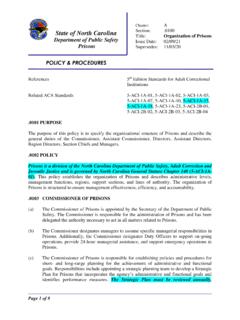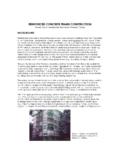Transcription of Tourism Impacts - GOV.UK
1 ECONOMIC AND PRIVATE SECTOR PROFESSIONAL evidence AND APPLIED KNOWLEDGE SERVICES HELPDESK REQUEST Tourism Impacts evidence of Impacts on employment, gender, income Alberto F. Lemma Overseas Development Institute July 2014 i EPS-PEAKS is a consortium of organisations that provides Economics and Private Sector Professional evidence and Applied Knowledge Services to the DfID. The core services include: 1) Helpdesk 2) Document library 3) Information on training and e-learning opportunities 4) Topic guides 5) Structured professional development sessions 6) E-Bulletin To find out more or access EPS-PEAKS services or feedback on this or other output, visit the EPS-PEAKS community on or contact Alberto Lemma, Knowledge Manager, EPS-PEAKS core services at Disclaimer Statement: The views presented in this paper are those of the authors and do not necessarily represent the views of Consortium partner organisations, DFID or the UK Government.
2 The authors take full responsibility for any errors or omissions contained in this report. ii Contents List of boxes , figures and tables iii Abbreviations iv 1 Introduction 1 Methodology 1 Summary of Findings 1 2 Impacts of Tourism on Growth, Employment, Income & Livelihoods 2 3 Impacts of Tourism on Gender 12 4 Impacts of Tourism on the Environment 15 5 Conclusions 19 References 20 Annex: A Note on the WTTC Methodology 22 iii List of boxes , figures and tables Box 1: Impacts of Tourism on Incomes & Employment in Nepal 10 Figure 1: Tourism Employment vis- -vis other Sectors, 2012 9 Figure 2: Tourism Carbon Emissions by Destination (2005) 16 Table 1: Components of Direct, Indirect & Induced Tourism contribution to GDP 3 Table 2.
3 Direct & Total GDP Contribution of Tourism in South Asia, 2013 4 Table 3: Table 3: Direct and Total Effects of Tourism on GDP, 2013 5 Table 4: Estimated no. of Jobs Created in Tourism (by region) 2012 - 2022 6 Table 5: Direct, Indirect & Total Contribution to Employment for South Asia in 2013 7 Table 6: Global Contribution of Tourism to Employment, 2013 8 Table 7: Women Hotel/Restaurant Employees by Region, 2010 (%) 12 Table 8: Women employees by occupational status, 2010 (%) 13 Table 9: Female Employment in Tourism visi-a-vis other Sectors, 2010 (%) 13 Table 10: Gender Gap in Tourism Wages in Europe, 2011 (%) 14 Table 11: Carbon Emissions from Tourism (2005) 16 Table 12: CO2 Emissions by region of origin and destination (2005) 17 Table 13.
4 Trampling Impacts on Vegetation and Soil 18 iv Abbreviations DFID UK s Department for International Development GATS General Agreement on Tariffs GDP Gross Domestic Product GHG Greenhouse Gases ILO International Labour Organisation UNEP United Nations Environment Programme UNWTO United Nations World Tourism Organisation WTTC World Travel & Tourism Council Tourism Impacts : evidence of Impacts on employment, gender, income 1 1 Introduction Methodology The paper, carried out under the DFID Economics and Private Sector Professional evidence and Applied Knowledge Services (EPS-PEAKS) framework seeks to answer the question of: Do we have clear evidence on Tourism s impact on income, jobs, gender and the environment?
5 The report uses a mixture of quantitative data of which the main sources were the World Travel& Tourism Council and the United Nations World Tourism Organisation as well as academic literature and information from relevant websites, where available. The report follows on from a previous EPS-PEAKS helpdesk which investigated the Impacts of Tourism strategies for poverty reduction in South Asia, hence it includes some examples (where data and case studies were available) of the Impacts of Tourism , on the above factors, within the region. Issues with the reliance on the use of WTTC indicators (see Annex 1 for further explanations on the WTTC methodology for evaluating impact ) for a number of economic estimators is a potential cause of concern for the methodology as it was not apparent whether the data coefficients used by the WTTC, especially for the indirect and induced Impacts of Tourism on GDP and employment clearly represent actual Impacts .
6 Environmental indicators for Tourism also present a challenge in terms of their reliability and availability. Summary of Findings Tourism Impacts economies through three interrelated routes direct, indirect and induced effects. These Impacts and the structure of the Tourism sector determine the sectors economic impact on a country. The impact of Tourism on both economic growth and employment is clearly positive, there is good quantifiable data and evidence that Tourism positively contributes to both economic growth (through measures of GDP) as well as on employment, both directly and indirectly. Estimating Tourism s overall impact on incomes is problematic due to limited evidence on income and wage effects at the global level.
7 Overall, available data shows positive Impacts on incomes as well as positive Impacts on both livelihoods and poverty. Good data on the gender Impacts of the sector are limited to the number of females employed in Tourism and the types of work they undertake, both showing positive Impacts . Data on pay equality and working hours is more limited, but both show that females are disadvantaged within Tourism . The environmental Impacts of Tourism are difficult to quantify whilst data on emissions is available (albeit old), there is limited data on other environmental Impacts . Anecdotal evidence does however suggest that Tourism can have negative environmental Impacts . Tourism Impacts : evidence of Impacts on employment, gender, income 2 2 Impacts of Tourism on Growth, Employment, Income & Livelihoods The section highlights the economic Impacts of the Tourism sector, looking at its contributions to growth, employment and incomes.
8 The section first looks at the three routes through which Tourism achieves its Impacts the direct, indirect and induced Impacts , subsequently assessing its Impacts on employment and on incomes. Economic Impacts of Tourism Tourism has direct, indirect and induced Impacts on local economies, these can often be largely divergent between countries, based on the structure of the sector but most importantly on how well linked Tourism activities are with the local economy. Greater linkages generally translate into higher levels of local economic activity (and growth), which tend to occur when Tourism enterprises source their goods and services (including labour) locally whilst low levels of economic linkages occur where Tourism enterprises are dependent on imports (including staff) to supply their demands.
9 The overall Impacts of the sector are the sum of the direct, indirect and induced effects (WTTC, 2012a): Direct Impacts : Represents the GDP generated by activities that directly deal with Tourism such as hotels, travel agents, airlines and tour operators as well as restaurants and other activities that cater to tourists. Indirect Impacts , Impacts which accrue due to the activities undertaken by the sector, and are a function of three different factors: 1. Capital Investment in Tourism : Includes capital investment within all sectors that are directly involved in the Tourism industry as well as spending by enterprises in other sectors on Tourism assets such as transport or accommodation. 2. Government Spending for Tourism : Government spending to support the Tourism sector, which can include both national and local spending.
10 Activities include Tourism promotion, visitor services, administration etc. 3. Supply Chain Effects: These represent the purchase of domestic goods and services, as inputs to the production of their final outputs, by enterprises within the Tourism sector. Induced Impacts : Represents the wider contribution of Tourism through the expenditures of those who are directly or indirectly employed by the Tourism sector. Table 1 (below) shows the different components of the direct, indirect and induced Impacts of Tourism on an economy. The table highlights the different activities that are undertaken at the three levels of impact direct Impacts will be accrued through the activities of accommodation or Tourism transport services, indirect contributions through expenditure on food and beverage suppliers to Tourism enterprises, whilst induced Impacts will be the expenses of people working in the Tourism sector (or benefitting from the sector) within the local economy.













